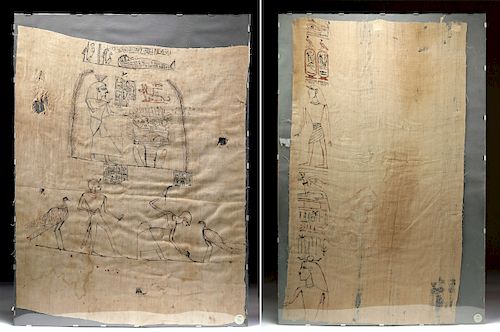Two Egyptian Ptolemaic Embalming Linens, ex Sotheby's
Lot 14
About Seller
Artemis Fine Arts
686 S Taylor Ave, Ste 106
Louisville, CO 80027
United States
Selling antiquities, ancient and ethnographic art online since 1993, Artemis Gallery specializes in Classical Antiquities (Egyptian, Greek, Roman, Near Eastern), Asian, Pre-Columbian, African / Tribal / Oceanographic art. Our extensive inventory includes pottery, stone, metal, wood, glass and textil...Read more
Categories
Estimate:
$6,000 - $9,000
Absentee vs Live bid
Two ways to bid:
- Leave a max absentee bid and the platform will bid on your behalf up to your maximum bid during the live auction.
- Bid live during the auction and your bids will be submitted real-time to the auctioneer.
Bid Increments
| Price | Bid Increment |
|---|---|
| $0 | $25 |
| $300 | $50 |
| $1,000 | $100 |
| $2,000 | $250 |
| $5,000 | $500 |
| $10,000 | $1,000 |
| $20,000 | $2,500 |
| $50,000 | $5,000 |
| $100,000 | $10,000 |
| $200,000 | $20,000 |
About Auction
By Artemis Fine Arts
Feb 13, 2020
Set Reminder
2020-02-13 10:00:00
2020-02-13 10:00:00
America/New_York
Bidsquare
Bidsquare : Exceptional Antiquities, Asian, Ethnographic
https://www.bidsquare.com/auctions/artemis-gallery/exceptional-antiquities-asian-ethnographic-4848
An important one-day auction featuring museum-worthy examples of Egyptian, Greek, Roman, Etruscan, Near Eastern, Far East / Asian, Pre-Columbian, African / Tribal, Oceanic, Native American, Spanish Colonial, Russian, Fossils, Ancient Jewelry, Fine Art, so much more! Artemis Fine Arts info@artemisfinearts.com
An important one-day auction featuring museum-worthy examples of Egyptian, Greek, Roman, Etruscan, Near Eastern, Far East / Asian, Pre-Columbian, African / Tribal, Oceanic, Native American, Spanish Colonial, Russian, Fossils, Ancient Jewelry, Fine Art, so much more! Artemis Fine Arts info@artemisfinearts.com
- Lot Description
Egypt, Ptolemaic Period, ca. 332 to 30 BCE. A fine set of two rare linen panels of sizable rectangular forms that are woven from coarse flax fibers and used during the linen-wrapping phase of the embalming process. The first panel is decorated with applied red and black ink and features (from top to bottom) two figures next to and a line of hieroglyphs above a sarcophagus, a figure gesturing towards an overflowing offering table with three columns of hieroglyphs and a couchant Anubis, and two field workers flanked by two large birds and a spitting snake. The larger panel features a column with a striding figure beneath a couchant Anubis and the two-part cartouche for Pharaoh Ramesses the Great (ca. 1279 - 1213 BCE), another Anubis and a wedjat above a plinth, and four hieroglyphs which translate to "Ramesses" above the torso of a second figure. Embalming linens were inscribed with scenes and hieroglyphs like these to protect the deceased. Size of largest (column): 20.125" W x 35.125" H (51.1 cm x 89.2 cm); (display frame): 24" W x 35.9" H (61 cm x 91.2 cm).
For an example of the embalming linen from the tomb of Tutankhamun, please see The Metropolitan Museum of Art, accession number 09.184.220.
Another stylistically similar example, from the Third Intermediate Period and of a larger size, hammered for $18,750 at Christie's, New York "Antiquities" auction (sale 2056, December 9, 2008, lot 19).
Provenance: private New York, New York, USA collection; ex-Seward Kennedy estate collection, New York, USA, London, England, and Paris, France, acquired between 1955 and 2015; ex-Sotheby & Co., London, New Bond Street "Egyptian, Western Asiatic, Greek, Etruscan and Roman Antiquities, Islamic Pottery and Metalwork, Indian Sculpture, African, Oceanic, Pre-Columbian and American Indian Art" auction (May 20, 1969, lots 132 & 133). Seward Kennedy assembled his 'cabinet of curiosities' over a period of more than six decades, seeking out treasures from across the world, which came to layer the surfaces of his residences in London, Paris, and New York City. Kennedy, who was a successful lawyer, rejected the title of 'collector' and instead saw himself as a custodian of remarkable objects.
All items legal to buy/sell under U.S. Statute covering cultural patrimony Code 2600, CHAPTER 14, and are guaranteed to be as described or your money back.
A Certificate of Authenticity will accompany all winning bids.
We ship worldwide and handle all shipping in-house for your convenience.
#147720Both panels have minor fraying, loosening, and losses to some interior and peripheral threads, with fading to areas of original pigment, and light staining commensurate with embalming. Great traces of original pigment and imagery throughout.Condition
- Shipping Info
-
All shipping is handled in-house for your convenience. Your invoice from Artemis Gallery will include shipping calculation instructions. If in doubt, please inquire BEFORE bidding for estimated shipping costs for individual items.
-
- Buyer's Premium



 EUR
EUR CAD
CAD AUD
AUD GBP
GBP MXN
MXN HKD
HKD CNY
CNY MYR
MYR SEK
SEK SGD
SGD CHF
CHF THB
THB


















